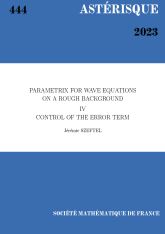Un nouveau calcul non-formel et non-commutatif : associativité et régularisation des parties finies
A new nonformal noncommutative calculus : Associativity and finite part regularization
Astérisque | 2008
- Consulter un extrait
- Année : 2008
- Tome : 321
- Format : Électronique
- Langue de l'ouvrage :
Anglais - Class. Math. : 53D55, 53D10; 46L65
- Pages : 267-297
- DOI : 10.24033/ast.796
Nous interprêtons l'élément $\frac {1}{2i\hbar }(u\mathbin {*}v+v\mathbin {*}u)$ dans les générateurs $u, v$ de l'algèbre de Weyl $W_2$ en tant qu'indéterminés dans ${\mathbb N}+\frac {1}{2}$ ou $-({\mathbb N}+\frac {1}{2})$, en utilisant des méthodes du calcul transcendental décrit dans l'annonce [?]. Le but principal de cet article est de donner une preuve rigoureuse de la partie de [?] qui introduit ce phénomène indéterminé. À savoir, nous discutons la manière d'obtenir l'associativité dans le calcul transcendental et de montrer comment la procédure de parties finies de Hadamard peut être implémentée dans notre contexte.
Algèbre de Weyl, calcul transcendental


